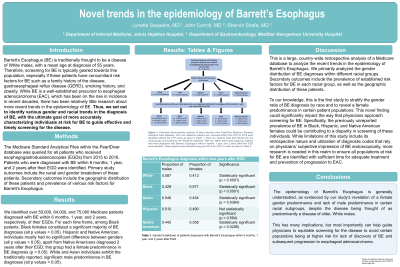Tuesday Poster Session
Category: Esophagus
P3243 - Novel Trends in the Epidemiology of Barrett’s Esophagus: Revealing Previously Unreported Gender Trends in Certain Racial Populations
Tuesday, October 24, 2023
10:30 AM - 4:00 PM PT
Location: Exhibit Hall

Has Audio

Lynette Sequeira, MD
Johns Hopkins Hospital
Baltimore, MD
Presenting Author(s)
Lynette Sequeira, MD1, John Carroll, MD2, Shervin Shafa, MD2
1Johns Hopkins Hospital, Baltimore, MD; 2MedStar Georgetown University Hospital, Washington, DC
Introduction: Barrett’s Esophagus (BE) is traditionally thought to be a disease of White males; thus, screening for BE is typically geared towards this population. While BE is a known precursor to esophageal adenocarcinoma (EAC), which has recently been rising in incidence, there has been little research about more recent trends in the epidemiology of BE. We set out to identify gender and racial trends in the diagnosis of BE, with the ultimate goal of more accurately characterizing individuals at risk for BE, to guide effective and timely screening for the disease.
Methods: The Medicare Standard Analytical Files within the PearlDiver database was queried for all patients who received esophagogastroduodenoscopies (EGDs) from 2015 to 2016. Patients who were diagnosed with BE within 6 months, 1 year, and 2 years after their EGD were identified. Primary study outcomes include the racial and gender breakdown of these patients. Secondary outcomes include the geographic distribution of these patients and prevalence of various risk factors for Barrett’s Esophagus.
Results: We identified over 50,000, 64,000, and 75,000 Medicare patients diagnosed with BE within 6 months, 1 year, and 2 years, respectively, of their EGDs. For each time frame, among Black patients, Black females constituted a significant majority of BE diagnoses (all p values < 0.05). Hispanic and Native American individuals mostly had no significant difference between genders (all p values > 0.05), apart from Native Americans diagnosed 2 years after their EGD; this group had a female predominance in BE diagnosis (p < 0.05). White and Asian individuals exhibit the traditionally reported, significant male predominance in BE diagnoses (all p values < 0.05).
Discussion: To our knowledge, this is the first study to stratify the gender ratio of BE diagnosis by race and to reveal a female predominance in certain patient populations. This novel finding could significantly impact the way that physicians approach screening for BE. Specifically, the previously unreported prevalence of BE in Black, Hispanic, and Native American females could be contributing to a disparity in screening of these individuals. While limitations of this study include its retrospective nature and utilization of diagnostic codes that rely on physicians’ subjective impression of BE endoscopically, more research is needed in this realm to ensure all populations at risk for BE are identified with sufficient time for adequate treatment and prevention of progression to EAC.
Disclosures:
Lynette Sequeira, MD1, John Carroll, MD2, Shervin Shafa, MD2. P3243 - Novel Trends in the Epidemiology of Barrett’s Esophagus: Revealing Previously Unreported Gender Trends in Certain Racial Populations, ACG 2023 Annual Scientific Meeting Abstracts. Vancouver, BC, Canada: American College of Gastroenterology.
1Johns Hopkins Hospital, Baltimore, MD; 2MedStar Georgetown University Hospital, Washington, DC
Introduction: Barrett’s Esophagus (BE) is traditionally thought to be a disease of White males; thus, screening for BE is typically geared towards this population. While BE is a known precursor to esophageal adenocarcinoma (EAC), which has recently been rising in incidence, there has been little research about more recent trends in the epidemiology of BE. We set out to identify gender and racial trends in the diagnosis of BE, with the ultimate goal of more accurately characterizing individuals at risk for BE, to guide effective and timely screening for the disease.
Methods: The Medicare Standard Analytical Files within the PearlDiver database was queried for all patients who received esophagogastroduodenoscopies (EGDs) from 2015 to 2016. Patients who were diagnosed with BE within 6 months, 1 year, and 2 years after their EGD were identified. Primary study outcomes include the racial and gender breakdown of these patients. Secondary outcomes include the geographic distribution of these patients and prevalence of various risk factors for Barrett’s Esophagus.
Results: We identified over 50,000, 64,000, and 75,000 Medicare patients diagnosed with BE within 6 months, 1 year, and 2 years, respectively, of their EGDs. For each time frame, among Black patients, Black females constituted a significant majority of BE diagnoses (all p values < 0.05). Hispanic and Native American individuals mostly had no significant difference between genders (all p values > 0.05), apart from Native Americans diagnosed 2 years after their EGD; this group had a female predominance in BE diagnosis (p < 0.05). White and Asian individuals exhibit the traditionally reported, significant male predominance in BE diagnoses (all p values < 0.05).
Discussion: To our knowledge, this is the first study to stratify the gender ratio of BE diagnosis by race and to reveal a female predominance in certain patient populations. This novel finding could significantly impact the way that physicians approach screening for BE. Specifically, the previously unreported prevalence of BE in Black, Hispanic, and Native American females could be contributing to a disparity in screening of these individuals. While limitations of this study include its retrospective nature and utilization of diagnostic codes that rely on physicians’ subjective impression of BE endoscopically, more research is needed in this realm to ensure all populations at risk for BE are identified with sufficient time for adequate treatment and prevention of progression to EAC.
Disclosures:
Lynette Sequeira indicated no relevant financial relationships.
John Carroll indicated no relevant financial relationships.
Shervin Shafa: Pentax Medical – Consultant.
Lynette Sequeira, MD1, John Carroll, MD2, Shervin Shafa, MD2. P3243 - Novel Trends in the Epidemiology of Barrett’s Esophagus: Revealing Previously Unreported Gender Trends in Certain Racial Populations, ACG 2023 Annual Scientific Meeting Abstracts. Vancouver, BC, Canada: American College of Gastroenterology.
